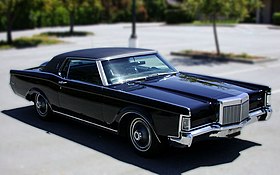Lincoln Continental Mark III
| Lincoln Mark III | |
|---|---|

1969 Lincoln Continental Mark III
|
|
| Overview | |
| Manufacturer | Lincoln (Ford) |
| Production | 1968–1971 |
| Assembly | Wixom Assembly, Wixom, Michigan |
| Body and chassis | |
| Class | Personal luxury car |
| Body style | 2-door coupe |
| Layout | FR layout |
| Related |
Ford Thunderbird (fifth generation) Lincoln Continental (1961-1969) |
| Powertrain | |
| Engine | 460 cu in (7.5 L) V8 (385 family) |
| Transmission | 3-speed C6 automatic |
| Dimensions | |
| Wheelbase | 117.2 in (2,977 mm) |
| Length | 216.1 in (5,489 mm) |
| Width | 79.4 in (2,017 mm) |
| Height | 53.0 in (1,346 mm) |
| Curb weight | 4,866 lb (2,207 kg) |
| Chronology | |
| Predecessor | Continental Mark II |
| Successor | Lincoln Continental Mark IV |
The Lincoln Continental Mark III is a personal luxury car of the Lincoln Mark series, that was produced by Lincoln and sold in North America in the 1969 through 1971 model years.
The 1969 Mark III was created when Lee Iacocca, president of Ford Motor Company at the time, directed Design Vice President, Gene Bordinat, to "put a Rolls Royce grille on a Thunderbird" in September 1965. The Mark III was based on the fourth generation Lincoln Continental (1961-1969) and the four-door fifth generation Thunderbird introduced for 1967. With the Thunderbird "dying in the marketplace" Iacocca wanted to put the company's development investment to better use by expanding its platform over several models.
The Mark III was intended to compete head-to-head with the top of the domestic personal luxury car market, Cadillac's heavily redesigned front wheel drive Eldorado. This placed it above the second tier premium personal luxury cars such as the Ford Thunderbird, Buick Riviera and Oldsmobile Toronado. As the Eldorado was built upon the Toronado frame, the Mark III's was based off the Thunderbird's. While the side-rail frame was identical to the Thunderbird's, the Mark III bore almost 300 lb (140 kg) more bodywork. Power was adequate from Lincoln's Ford 385 engine-based 460 cu in (7.5 l) 365 bhp (272 kW) V8.
Introduced in April 1968 as an early 1969 model, the model was a remarkable commercial success because it combined the high unit revenue of a luxury model with the low development costs and fixed cost–amortizing utility of platform-sharing, in a car that was appealing enough to buyers that many units were sold. Iacocca said, "We brought out the Mark III in April 1968, and in its very first year it outsold the Cadillac Eldorado, which had been our long-range goal. For the next five years [Marks III and IV] we had a field day, in part because the car had been developed on the cheap. We did the whole thing for $30 million, a bargain-basement price, because we were able to use existing parts and designs." Iacocca explained that this transformed the Lincoln-Mercury Division from losing money on every luxury car (via low unit sales on high fixed costs) to a profit center, making the new Mark series as big a success as any he ever had in his career—a remarkable statement from an executive who led the programs for the original Ford Mustang and the Chrysler minivan family. Iacocca explained of the Mark series, "The Mark is [in 1984] Ford's biggest moneymaker, just as Cadillac is for General Motors. It's the Alfred Sloan theory: you have to have something for everybody [...] you always need a poor man's car [...] but then you need upscale cars, too, because you never know when the blue-collar guy is going to be laid off. It seems that in the United States the one thing you can count on is that even during a depression, the rich get richer. So you always have to have some goodies for them."
...
Wikipedia
